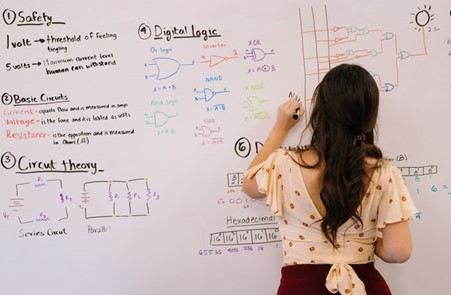Heidi Schave of Alameda, California is a museum director, lecturer, and educator. With a deep interest in arts and science education, in the article that follows Heidi Schave discusses the news related to STEM education from around the country.
An inclusive classroom may lead to a classroom that’s more interested in STEM subjects both in and out of school explains Heidi Schave.
That’s according to a new North Carolina State University study pinpointing a possible key to better promotion of STEM education. The study
surveyed over 500 students in five high schools about the inclusivity of their STEM classes, and how they felt their classroom welcomes different ethnic groups and genders.
Heidi Schave says it also looked at whether they felt teachers treated students fairly and if they felt like they belonged in the class.
In addition, a set of questions addressed whether they believe they could solve community problems related to tactics learned in their STEM classes, such as drinking water contamination.
Researchers found that most students see their STEM classroom as particularly inclusive and that they were fairly treated, but that as their high school education progressed, their positive view of STEM classroom inclusivity declined. If a teacher was viewed as fair, a student was generally more engaged in class and felt more empowered to solve real-world STEM issues.
The bottom line: the feeling of belonging matters to students according to Heidi Schave, especially those interested in solid STEM training.
Heidi Schave says U.S. Makes Plans to Attract Foreign Students
Heidi Schave reports that the Biden administration recently announced changes to policies in the hopes of attracting more students from around the world who are interested in STEM subjects.
The goal: Making the American economy more competitive on a global scale. The United States State Department will now allow visiting students specializing in STEM to finish as much as 36 months of training, as well as start a program to better connect businesses in the United States with international STEM students.
Additionally, there will be 22 study fields added to a program that allows foreign graduates from American universities to complete three more years of training with U.S. employers. Such new study fields include data visualization, data science, and cloud computing.
Heidi Schave explains the policy changes come after data from the government showed that such international students increasingly fuel progressive STEM research in the United States.
Futurescape Platform Finds More Students Considering STEM Careers
A survey conducted on Futurescape, a platform where students can explore STEM careers and study educational requirements for various careers, finds that the most popular career considerations have either a digital or STEM focus.
The nonprofit American Student Assistance, which runs the Futurescape platform, surveyed more than 2,000 middle and high school students from across every state, with students representing a range of ethnicities and incomes according to Heidi Schave.
More than half of the platform’s student users come from households with incomes that are considered below the median level in their states.
Among the key findings: 17% said biomedical engineering was their top career choice, followed by medical sciences (16%), animation and multimedia art (10%), graphic design (8%), and psychology (8%).
Those who said they were interested in a type of digital career were 78% female, and 78% of survey respondents said the platform exposed them to careers that they either hadn’t known or considered before.

An effort to Expand Robotics Program Launches in Indiana
Heidi Schave reports the Indianapolis-based TechPoint Foundation for Youth has
launched a campaign to encourage more children of color and girls to consider tech careers through its State Robotics Initiative.
The goal is to add 1,000 more participants to the after-school program that is being used in nine K-12 schools through a robotics curriculum called VEX GO. About 24,000 students currently participate in the SRI program, which includes a yearly VEX Robotics state competition among more than 270 school teams.
The TechPoint Foundation aims to start the program in 10 more schools this year, and notes that girls and students of color participating in the program gain confidence overall in STEM fields and become more interested overall in a future STEM career.
New Mexico Center Aims to Expand STEM Learning Opportunities
Heidi Schave reports that New Mexico’s Very Large Array Learning Center has announced a project to enhance and expand opportunities for STEM students in Socorro County and beyond.
The National Radio Astronomy Observatory, which runs the Very Large Array, says it has submitted a $10 million request for a planned Next Generation Learning Center at the VLA.
The center would boost STEM education in the area to expand the number of highly trained STEM personnel available in the state which would in turn attract regional economic development.
The current plan is to create a physical STEM education learning place for both in-person and virtual classes available to K-12 students. Heidi Schave says it also aims to make STEM education more diverse and inclusive. About 60% of New Mexico students are Latino while 11% identify as Native American.
